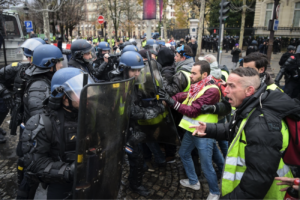By Clément Streiff
They have been in every car since 2008, back when new road security policies were implemented. Yellow vests used to be worn for safety, until an official statement regarding a tax increase on oil prices for environmental purposes issued by the French government in May provoked national outrage on social media. Seeing as driving is essential for those living out of the city, videos accusing Macron’s policies to be targeting the lower class started to abound, calling for a popular uprising. Very soon, a national network was established through YouTube, Facebook, and Twitter, and the first wave of protests occurred on 17 November throughout the whole country. Roads were blocked in more than 1,500 towns or cities. It has become impossible for the French to be indifferent: either you love them, or you hate them.

Protesters clashing with police officers during the protest of 24 November in Paris. © LUCAS BARIOULET/AFP
Among these thousands wearing a yellow vest, we can find as many women as men according to the sociologist Benoît Coquard, and most of them are farm laborers, small shopkeepers, crafts(wo)men, etc., belonging to the lower and middle economic classes. Their claims? It is not only the decrease in taxes related to oil price, but also the end of an intense tax system that represents 48.4% of the GDP, according to Eurostat. On November 30, the movement released an official list of forty-two claims, including, among many others. the increase of the minimum wage, the protection of local institutions, and a more developed and fairer scale system to determine taxes, that would take into account more precise economic situations, hence helping the poorest households. Their common feature? Wearing a yellow vest, used as the universal symbol of the movement.
President Emmanuel Macron and his Prime Minister Edouard Philippe have been trying to appease their anger for several weeks. Four people have already died during the protests, while more than seven hundred were injured. The last wave of protests on Saturday, December 1, was one of the most impressive and violent, and lead to pictures of a burning Paris on the front page of several world-renowned newspapers. In the capital city, the amount of damage and the loss of profit from tourism resulting from the demonstration were assessed at four million euros altogether. Monuments like the Arc de Triomphe were vandalized and tagged. The police used tear gas and water cannons to fight the protesters, who were more than eight thousand in Paris, and more than one hundred thousand across the country. A legitimate use of force according to some, who like to remind of the incredible violence of some protesters; while others called it a scandalous abuse of power on the population.

Protection devices were installed the day before the protest in Paris on 30 November. © BENOIT TESSIERS/REUTERS
On Monday, high school students joined the movement as more than a hundred schools were blockaded, to protest both the new reform on higher education issued by Macron’s government aiming to make French public universities’ admission policies selective, and to support the Yellow Vests movement. Moreover, Edouard Philippe recently confirmed the decision not to raise taxes on oil prices, a highly criticized choice that many perceived as incoherent and contradictory with the government’s guidelines. As of now, the leaders of the movement are still calling for an “Act IV” of protests in Paris next Saturday, causing national concern and worries, as another surge of violence is expected.
The movement, which some thinkers have compared to May 68, has not only monopolized every newsfeed in the nation but also puzzled newspapers, politicians and sociologists. Most agree to associate the movement with the lower and middle economic and social classes, whose buying power has been ever-shrinking for years. It also raises questions that seem to indicate the creation of a historical landmark: is this a new form of popular uprising? Could this have happened without social media? Are their claims legitimate? Because of the size of the protests, the whole nation has inevitably taken sides, and the debate can’t stop drawing more and more people into a spiral of political tensions.

Protesters set cars on fire all across Paris. © STEPHANE MAHE/REUTERS
The movement, supported as of now by 72% of the population according to the Harris survey agency, is to this day the biggest challenge Macron and his government have faced, whose approval rate has hit an ever-low record of twenty-six percent. The outcome of this movement is still highly uncertain. Delve into a more in-depth analysis of the uprising with these articles (in French):
- “La feuille d’impôt, le rond-point et Facebook: huit sociologues décryptent les gilets jaunes”, by Chloé Leprince for France Culture.
- “Gilets jaunes” : la voilà, la société civile voulue par Macron !”, by Carole Barjon for Le Nouvel Obs.
- “Et si les gilets jaunes étaient des écologistes qui s’ignorent ?”, by Jean-Baptiste Comby for Le Nouvel Obs.
Other posts that may interest you:
- LGBTQ+ History Month: Marsha P. Johnson, Queer Rights Activist
- Protestors Confront Reims Mayor About the Living Conditions for Refugees
- Euraf Candidate Interview: Lélio Coupreau
- Euraf Candidate Interview: Carla Jessica Ibata lobo
- Euraf Candidate Interview : François Méheut
Discover more from The Sundial Press
Subscribe to get the latest posts sent to your email.





